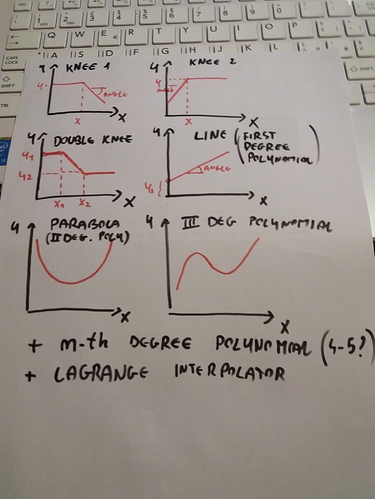Dear Sputnki,
Since the subject still seem to attract you.
I am very aware of the complexity spiral. Therefore the number of parameters for the most accesible version should be very low. More complex versions could still be made by addign more graph points and adding more esoteric fucntions but imagine this for th euser frienly version
An 8 point graph. Time on the X-axis is only set as an overall value over the whole graph length so the distance between the ponts will all be equal. So there are no indiviual times to be set. One can however adjust the total time from 0 to, say, 7 seconds, making the time between individual points change drom 0 to 1 second accordingly. The Y axis values could exist of a number between 1 and 127 which is a proven resolution from the MIDI standard that is good enough for almost any imaginable need (except certain tunign solutions in high octaves maybe but since the value can be connected to a note number it shouldn't when used chromatically. But I degress).
After point 8 there is a separate value for the release time of the curve. In principle this could have been taken care of by a 9th point on the graph but having an independant release time (so after key off) will partly compensate for the lack of individual time settign in the rest of the graph and thus keeping its resolution on the X-axis as low as possible, the of that being 8 x 127 points in this example.
With this tool one can already make / draw quite elaborate point to point shapes.
Now hear this: For the interpolation between the point on the graph I would propose 2 options:
1 - A straight line from pointt to point. In that case you can for instance create a single triangle shape with 3 points only. Furthermoree it is the bes tway to get rough sounding effects, not even squigly but harshly linear.
2 - A smoothing function that "'draws" a smooth graph through the point or maybe even an aproximation near to point curve would be even better. In that respect I do not yet have a clear vision of what woudl work best. Probably somehting to try out in practice.
Chosing linear or smoothed would then basically need one switch.
The next step would be to inlcude a loop portion in the graph to take the use into complex LFO teritorry. Instinctively I'd propose a loop from point 8 back to point 5 so that 4 points on the graph can be looped until key release, after which the extra release parameter takes over.
We are nowt taling about a tool with 12 input points. For instance 8 faders (for the Y levels of the points), 2 pots (for overall time and the individual relese time) and 2 switches (to activate smooth , linear being the default setting, and loop, no loop being the basic setting.
Imagine it. On a small 8 fader controller one could then set up a graphical representation of a curve. The resolution would obviously be low but that could actully be a benifit to produce brash, grindly low fi stiff. The smoothing function woudl compensate for the low number of points when smoothness is actually asked for.
Oops, In the end I have still describe tthe whole concpe tof my Swiss army knife. Let me know if oyu want to know more. I have even already made some sketches.
Which brings us to your "who needs this?" question. The whole attraction of a system like Axoloti is of course that one can work out personally customized soluitons, even if these are made uop out oif "conventional" elements. The next step is to think about improved elements for specific uses. So I am not thinking persé about the universal Swiss army knife but one that would attract peole who are susceptible to having more grpahic aids with a musical purpose.
I know, I know. You could now give me the same answer you just gave to Axoman but remember I just wrote this whole stuff because you seem to like the subject anyway. 




